 | E-mail to Birds Korea |
 | KWBS |
in the Region
 | The Oriental Bird Club |
 | BirdLife International (Asia) |
March
March often contains a mixture of dry, cold days (with night temperatures down to 3-4 C, and highs between 10 and 15 C) and occasional milder showery, windy weather.
Most wintering species are still present, but in progressively reduced numbers. Falcated Duck regularly display on reservoirs and ponds, while small numbers of Baikal Teal remain at key sites. Small numbers of shorebirds, including early Little Ringed Plover and flocks of Far Eastern Curlew start to arrive, plus Buff-bellied Pipits and the first leucopsis White Wagtails. In the right weather conditions, by mid-month large numbers of Rustic Buntings, Naumann’s and Dusky Thrushes can be found on offshore islands and along the coast after moving north-east out of China and north from Japan, along with smaller numbers of raptors and occasional influxes of Japanese Waxwing. Bramblings and Siskins too often form large flocks at key migration points. Sunny days tempt Rustic, Meadow, and Yellow-throated Buntings into song, and by month’s end the arrival of species like Bar-tailed Godwit, Stejneger’s Stonechat and Barn Swallow mark the beginning of the main northward migration period.
National firsts in March include Bar-headed Goose (2003), European Robin (2006), and Bonelli’s Eagle (2007).
Rason, DPRK, March 25 - 30
As part of an international initiative to improve conservation opportunities for threatened Northeast Asian species (including the White-naped Crane Grus vipio), a rapid assessment of birds and their habitats was conducted in Rason / lower Tuman River, far north-eastern DPRK, from March 26th to 31st 2014.

This survey was conducted with the support and participation of the Economic Cooperation Bureau of the People’s Committee of Rason City, the Hanns Seidel Foundation, the East and North East-Asia Office of the United Nations Economic and Social Commission for Asia and the Pacific (UNESCAP) and the Robert Bosch Foundation. A formal report is under preparation by UNESCAP and a more detailed account of the species recorded is / will soon be available on the Birds Korea website.
Counts were made using tripod-mounted telescopes and binoculars by Mr. Spike Millington (Chief of the East Asian-Australasian Flyway Partnership), Dr. Yuri Shibaev and Dr. Sergei Surmach (of the Far Eastern Branch of the Russian Academy of Sciences / Amur-Ussuri centre for Avian Biodiversity) and Dr. Nial Moores (Birds Korea), supported throughout by a team of regional experts and specialists.
Our bird-counting effort was focused primarily on three lakes (Manpo, Sobonpo and Dongbonpo), largely within the 3,200ha Sonbong Migratory Bird Reserve, on March 28th, 29th and 30th; with additional observations made en route between Josan and Rajin (on 26th and 31st); from our hotel in Rajin, especially on 26th, 27th and early 28th and 30th); along the coast near Sonbong, especially on 28th and 30th, near Uam Ri (in an area overlooking Al Island) on 30th; in woodland above Pipha Islet also on 30th; and in woodland above Rajin on the 31st.
Ramsar-defined internationally important concentrations of five species of waterbird were counted, and Ramsar-defined internationally important concentrations (of 20,000 or more waterbirds) were also counted on both Manpo and Sobonpo. In total, 110 bird species were recorded. These included several globally-threatened or near-threatened species occupying a broad range of habitats (i.e. Japanese Quail, Falcated Duck, Long-tailed Duck, White-naped Crane, Hooded Crane, Far Eastern Curlew, Great Knot, Relict Gull and Ochre-rumped Bunting), and apparently two new species for the DPRK were recorded (American Wigeon and Relict Gull).
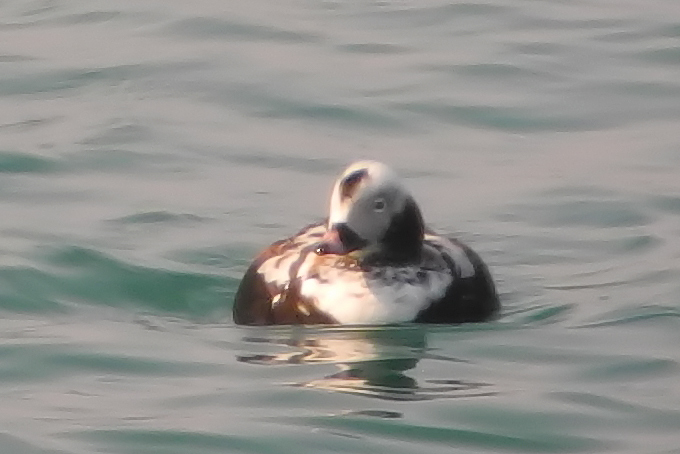
In addition, a mounted Mountain Hawk-Eagle Nisaetus nipalensis was found and photographed by our team in the international bookshop in central Rajin. According to the shop-workers, the bird was “procured” locally; and was apparently brought into the shop one or two winters earlier. accpording TO Austin’s account of the birds of Korea, there are only three records of this species in Korea – all from Gangwon Province dated January 1914; February 1925 and September 1934. However, the species now occurs regularly (apparently increasingly so) in Russian forests close to the border with northernmost DPRK.
The detailed species list is here.
Mara-do, Jeju, March 30
On a blustery day filled with low scudding clouds and rough seas, there was some interesting movement and turnover on Mara-do. Although most birds were perhaps sheltering from the winds, and despite the fact that I only had an hour on the island, there were some birds about. The feeling was decidedly different from the previous week, with winter birds clearing out, and more migrants and breeders moving through.
Notable on Jeju’s nearby mainland were several Garganey mixed in with Spot-billed Duck and Eurasian Teal. Also, Barn Swallows have returned in force.
- Black-crowned Night Heron Nycticorax nycticorax; presumably the same three individuals from last weekend
- Peregrine Falcon Falco peregrines; one prowling the rocks where tired migrants often shelter
- Eurasian Woodcock Scolopax rusticola; one flushed silently in front of me, flying straight and low – noticeably larger than snipes, with large ‘kestrel-colored’ rump very evident
- Black-tailed Gull Larus crassirostris
- Pacific Swift Apus Pacificus; at least 30 engaged in aerial ballet low over the island
- Eurasian Magpie Pica pica
- Great Tit Parus major
- Far Eastern Skylark Alauda japonica
- Barn Swallow Hirundo Rustica
- Japanese Bush Warbler Horornis diphone
- Japanese White-eye Zosterops japonicus
- White-cheeked Starling Spodiopsar cineraceus
- White’s Thrush Zoothera Aurea; one spotted in the woods with a Pale Thrush
- Pale Thrush Turdus pallidus
- Stejneger’s Stonechat Saxicola stejnegeri; one in a grassy field
- Daurian Redstart Phoenicurus auroreus
- White Wagtail Motacilla alba
- Hawfinch Coccothraustes Coccothraustes; one seen on the rocks
- Grey-capped Greenfinch Chloris sinica
- Yellow-throated Bunting Emberiza elegans
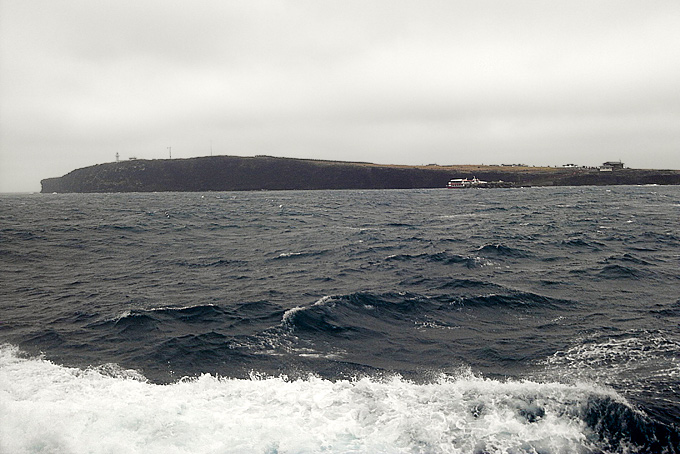
Aphae Island, March 27
The first check for this spring migration season revealed a small number of shorebirds on the southern tidal-flat: 113 Bar-tailed Godwit (one leg-flagged from New Zealand, one from Victoria Australia), 13 Great Knot (one leg-flagged), 11 Far-eastern Curlew, c. 30 Dunlin; a flock of c. 200 flew over heading southward, 23 Kentish Plover a handful of Grey Plover and 1 Far Eastern Oystercatcher. Also seen c. 80 Eurasian Wigeon, a few Eastern Spot-billed Duck, 4 Little Egret, 2 Grey Heron, c. 30 Black-tailed Gull and as the highlight 13 Saunders's Gull; only single individuals had been seen occasionally before.
On the former main roost location of the northern tidal-flat only 3 Kentish Plover and a few Eastern Spot-billed Duck were present, because sand had been excavated to form a lagoon; most likely incorporated with the construction work at the adjacent salt-ponts.
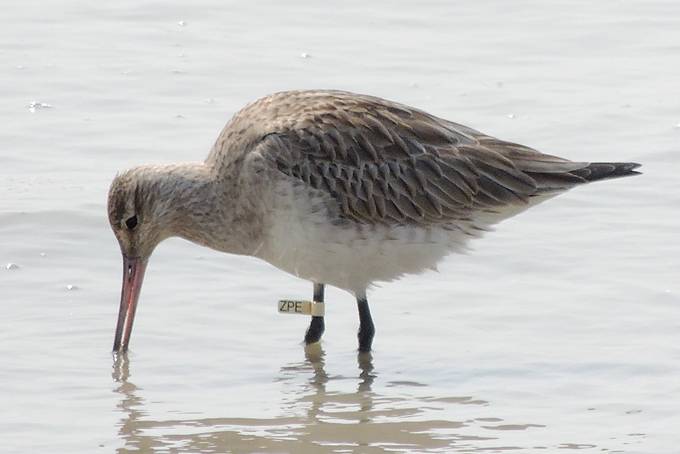
This bird was originally banded on 17.10.1993 aged as 3+ so it is now at least 23 1/2 years old and still travelling.
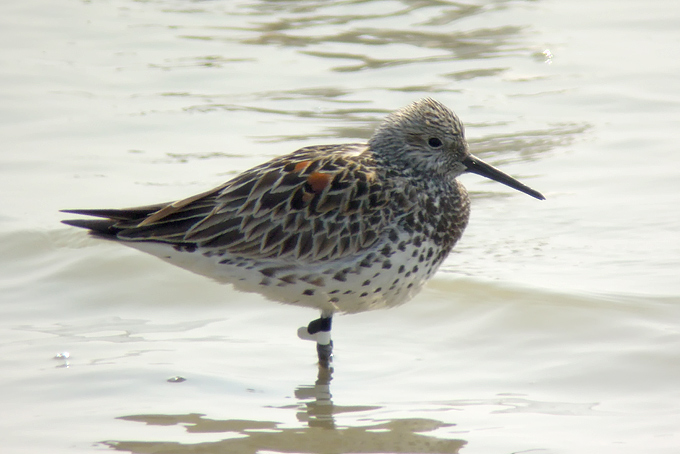
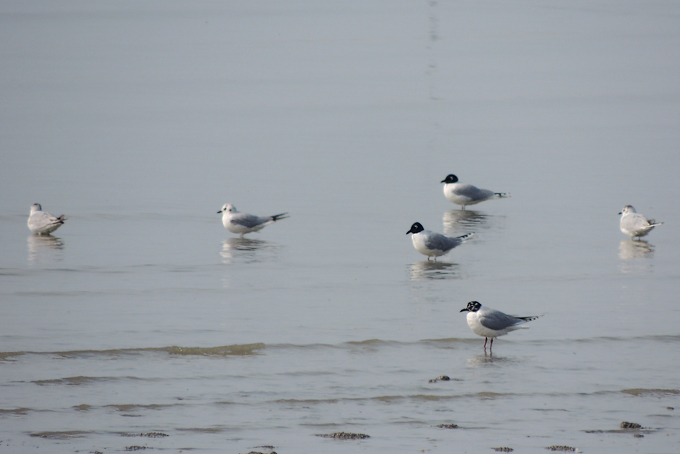
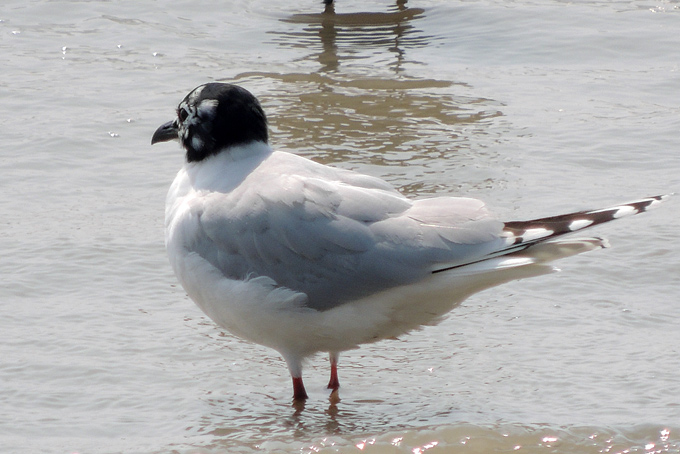
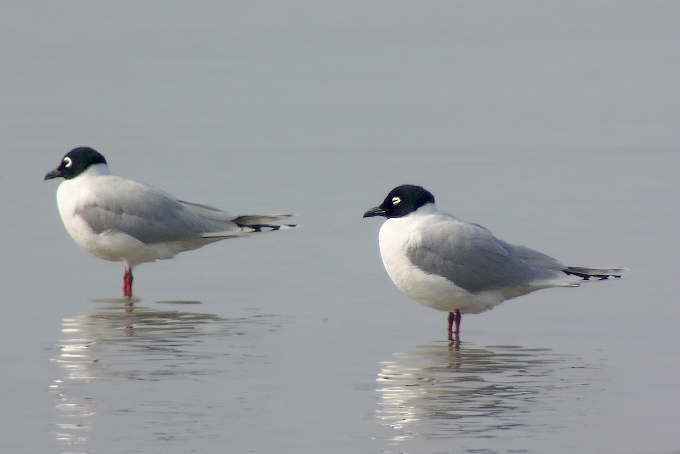
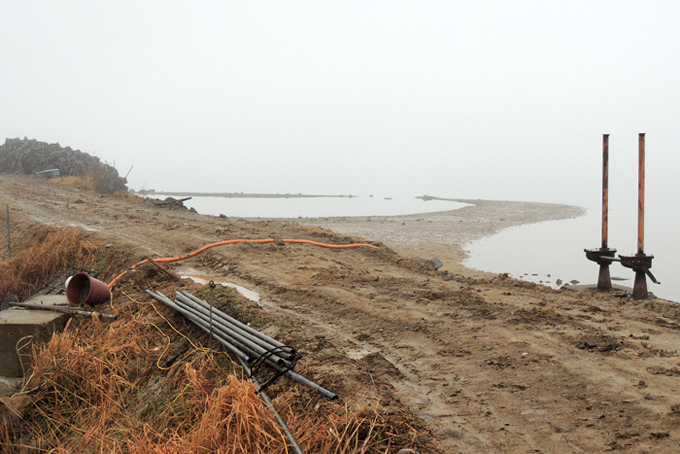
Jeju north coast, March 23
Sunday saw calm and warm weather after a windy and smoggy week on Jeju. Definite signs of spring movement noted, with some birds seemingly early. We saw a total of 61 species today, at parks in Jeju City, at Hado, and Seongsan. In Jeju City, a crisp Grey-backed Thrush was a real treat to watch as it perched in a tree. Three Chinese Grosbeaks and plentiful Pale Thrush were also noted in this park.
Near Seongsan, we stopped to look at gulls, and were surprised to see a Saunders’s Gull in summer plumage gracefully wheeling low to the water (a personal Jeju first). Very high overhead, three Cinereous Vultures circled on a thermal - probably Jeju’s strangely resident vultures.
At Hado, we were glad to see seemingly healthy numbers and diversity of waterfowl, in spite of disruptive spraying and other showy/dubious AI countermeasures. The Black-faced Spoonbills that regularly overwinter at Hado, however, have stayed away, and some can be found near Seongsan at a far less ideal site located next to a new walking trail. A new viewing platform has been built much closer to the reservoir at Hado, and worryingly, a picnic gazebo – right at the water’s edge.
Also at Hado, two more relatively dark-faced Meadow Buntings were seen. I’ve seen plenty of Meadow Buntings on Jeju over the years, but never with such dark facial markings. They also seemed to make a more ‘tingy’ insect-like call than I’m used to. How closely related to Japanese ciopsis Meadow Buntings are Jeju’s Meadow Buntings? Read Dr. Nial Moores’ excellent ID notes here: http://www.birdskorea.org/Birds/Identification/ID_Notes/BK-ID-Meadow-Bunting.shtml
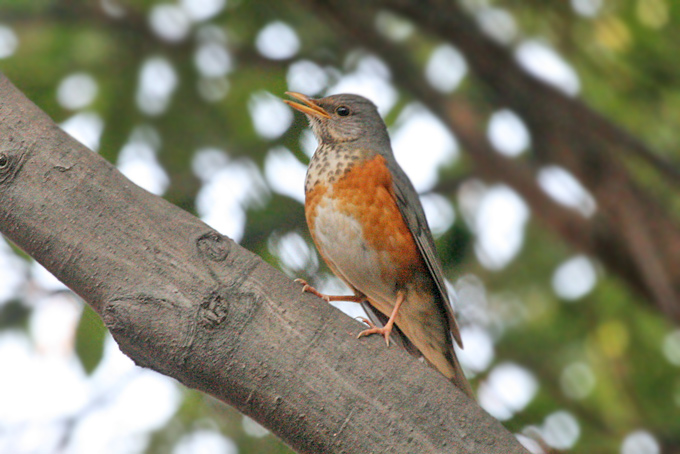
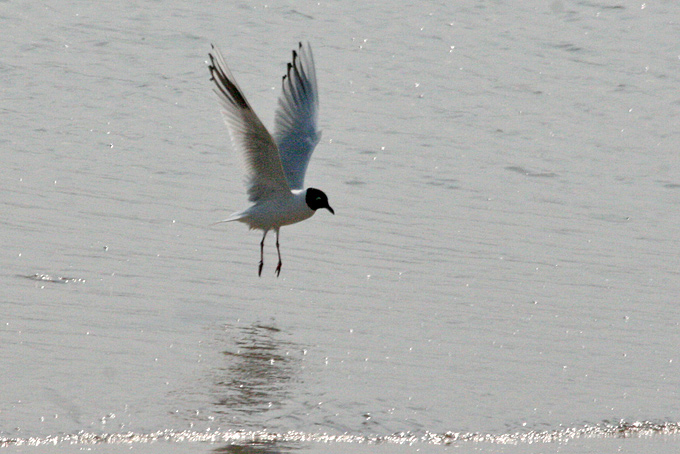
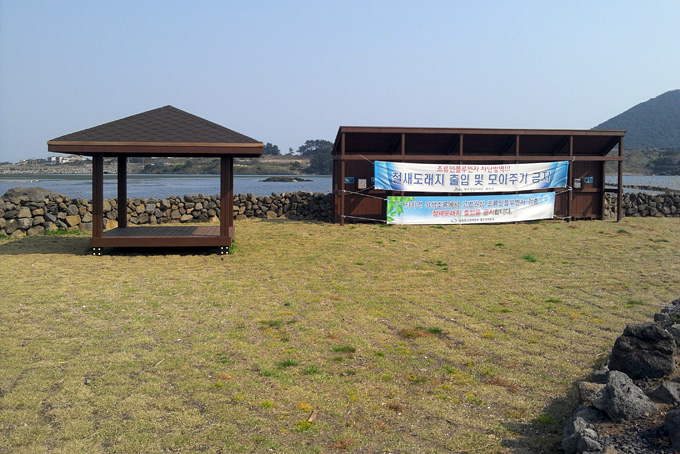
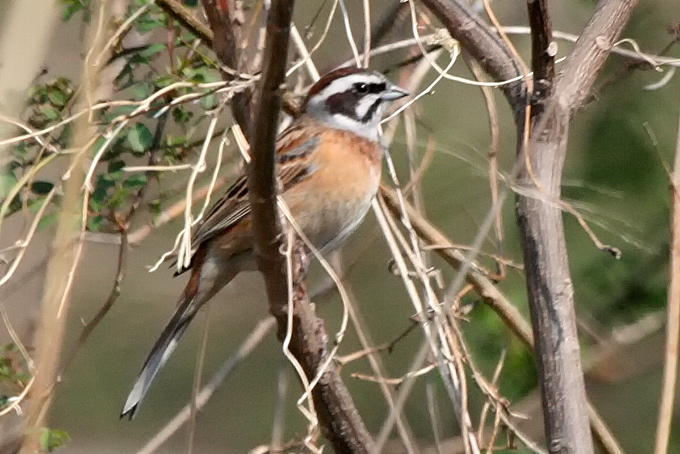
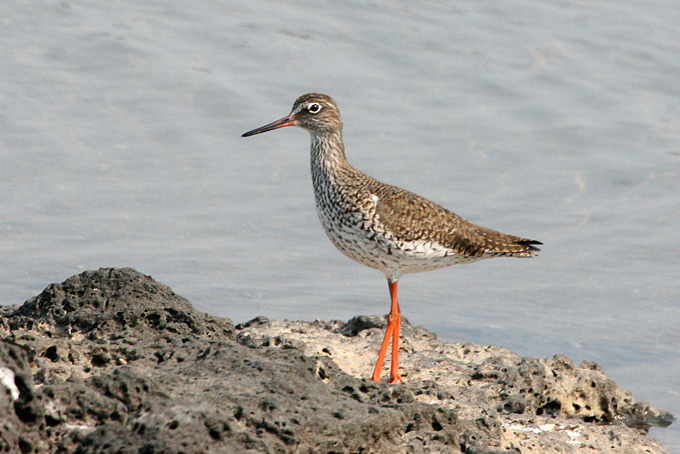
Mara-do, Jeju, March 22
Largely the same feeling today on Mara when compared with last Saturday. The Oriental Plovers were missed, and a few new birds were noted, like Black-crowned Night Heron, Hoopoe, Eurasian Wren, Chinese Grosbeak and Eurasian Siskin. Distressingly, a large orange cat was seen prowling in the woods, the first time I’ve observed this. One can only imagine how many exhausted migrants this cat will kill in the coming weeks and months.
- Great Crested Grebe Podiceps cristatus
- Black-crowned Night Heron Nycticorax nycticorax; three seen circling before settling in the tallest trees on the island
- Peregrine Falcon Falco peregrinus
- Black-tailed Gull Larus crassirostris
- Ancient Murrelet Synthliboramphus antiquus
- Hoopoe Upupa epops
- Eurasian Magpie Pica pica
- Great Tit Parus major
- Far Eastern Skylark Alauda japonica
- Barn Swallow Hirundo Rustica
- Japanese Bush Warbler Horornis diphone
- Japanese White-eye Zosterops japonicus
- Eurasian Wren Troglodytes troglodytes; one briefly seen at the edge of the woods
- Dusky Thrush Turdus eunomus
- Daurian Redstart Phoenicurus auroreus
- Blue Rock Thrush Monticola solitarius
- Eurasian Tree Sparrow Passer montanus; 30+ in the village
- White Wagtail Motacilla alba
- Chinese Grosbeak Eophona migratoria; a flock of 12+ was restlessly roaming the island
- Grey-capped Greenfinch Chloris sinica
- Eurasian Siskin Carduelis spinus; one heard
- Meadow Bunting Emberiza cioides; one individual with mostly black (as opposed to brown) head pattern – darkest I’ve seen on Jeju...
- Yellow-throated Bunting Emberiza elegans; 20+ in the woods

Various Locations, March 14 - 22
During the week of 14th-22nd, several birding hotspots were visited, in weather that ranged from very windy and quite cold (especially on the 20th) to sunny and seasonally warm (most especially the 22nd, when a high of 15C). Sites visited included the Han River (NM only, on 14th); North River (on 15th); Namhansanseong and Han-Imjin (on 16th, when also joined by Frank Coenjaerts); Cherowon and Han-Imjin again (on 17th, again with FC); Baekryeong Island (18th-20th); Seosan (21st); and the Geum Estuary (on 22nd).
The trip was timed to see some late departing winter visitors and to catch a few early migrants. Highlights included two encounters with Swan Goose; a Ring-necked Duck; a large flock of Baikal Teal; flocks of White-naped and especially of Hooded Cranes; Oriental Stork at two locations; Yellow-bellied Tits at several sites; a flock of Pine Bunting; good numbers of early-spring migrants; and excellent views of an Amur Leopard Cat. Although the birding was excellent, the rampant destruction of key sites continues unabated – with bulldozers in action at almost all of the sites we visited: Green Growth in action.
Selected species of note include:
- Hazel Grouse Tetrastes bonasia. One was seen briefly at Namhansanseong on 16th, with two others heard there.
- Japanese Quail Coturnix japonica. Two were seen in the main marsh on Baekryeong Island on the 18th.
- Swan Goose Anser cygnoides. Four were seen well on the Han-Imjin on the 17th (though no evidence there this spring of the large staging flock that was regular here in the early 2000s) and 14 were still at the Geum Estuary on the 22nd.).
- Ruddy Shelduck Tadorna ferruginea. Approximately 300 were on the Song Do lagoon in Incheon on the 17th and 70 were watched apparently departing Seosan on the 21st.
- Baikal Teal Anas formosa. Three were at Cheorweon on 17th; one was on Baekryeong Island on 18th and 19th; and 22,000 were still present on the Geum River on the 22nd.
- Ferruginous Duck Aythya nyroca. One or two were still with the 2,600-strong Tufted Duck flock on the Han River on the 14th (NM only).
- Ring-necked Duck Aythya collaris. A female (apparently an adult) was found and photographed on the Han River on the 14th (NM only), and was seen by multiple observers on the 15th at least. Fuller review of images of the Chungju bird (a first for Korea, found on January 14th and apparently last seen the same month) is needed to establish whether the Han River bird was the same individual that had simply relocated c. 150km north or was instead a second individual.
- Scaly-sided Merganser Mergus squamatus.Probably 15 were still present on part of the North River on the 15th.
- Oriental Stork Ciconia boyciana. Three were on Baekryeong Island on 18th and one was at Seosan on the 21st.
- Black-faced Spoonbill Platalea minor. One was at the Han-Imijin on the 16th; two were at Song Do on the 17th; and one was at Seosan on the 21st.
- Intermediate Egret Egretta intermedia. One, the personal first of the spring, was on Baekryeong Island on the 19th.
- Upland Buzzard Buteo hemilasius. One was on Baekryeong Island on the 19th.
- White-naped Crane Grus vipio. Eight were seen at the Han-Imjin on the 16th and approximately 120 were seen in a small area of Cheorwon on the 17th. (According to Lee Ki-Sup, two Siberian Crane were also still present in Cheorwon on the 16th).
- Red-crowned Crane Grus japonensis. Only two were seen at Cheorwon on the 17th.
- Common Crane Grus grus. An adult and two Second Calendar-years (considered more likely to be pure than hybrid) were at Seosan on the 21st.
- Hooded Crane Grus monacha. A conservative 3,100 were counted (in blocks of 100) from one viewing point at Seosan on the 21st (my personal highest day count of the species in the ROK, presumably containing many birds from Izumi in Japan) and 41 flew north over the Geum Estuary early in the morning of the 22nd.
- Northern Lapwing Vanellus vanellus. At Seosan on the 21st, one flock contained 113 birds and another flock about 5km to the north contained 58. Several of the birds were displaying actively, both in flight and on the ground. This is perhaps one of the highest day-counts of this species in the ROK.
- Bar-tailed Godwit Limosa lapponica. At least 110 early-arrivers were counted at the Geum Estuary on the 22nd.
- Far Eastern Curlew Numenius madagascariensis. Two were on Baekryeong Island on the 19th; seven were at Seosan on the 21st and at least 700 were at the Geum estuary on the 22nd.
- Common Redshank Tringa totanus. One or two were at Seosan on the 21st.
- Great Knot Calidris tenuirostris. One at the Geum Estuary on the 22nd was the personal first of the spring.
- Ruff Philomachus pugnax. Two were at Seosan on the 21st.
- Saunders’s Gull Chroicocephalus saundersi. At least 110 were at Seosan on the 21st, and c. 10 were also at the Geum Estuary on the 22nd.
- Caspian / Steppe Gull Larus cachinnans / L. heuglini barabensis. One or perhaps two beautifully distinctive-looking yet still hard to ID individuals were present at the Geum Estuary on the 22nd. The best observed individual was obviously paler-saddled in direct comparison than taimyrensis, vegae and mongolicus.
- Eurasian Hoopoe Upupa epops. One or two on Baekryeong Island on the 19th were the personal first of the spring.
- Chinese Grey Shrike Lanius sphenocercus. One was seen very well near Wonju on the 15th.
- Yellow-bellied Tit Periparus venustulus. At least a dozen were heard or seen on Baekryeong Island on the 19th and 20th (either over-winterers or early spring migrants) and at least five (considered to be early spring migrants) were in coastal pines at two points close to the Geum Estuary on the 22nd.
- Lark sp. On Baekryeong Island on the 19th, a medium-sized and fairly long-tailed lark was seen and heard in flight over the southwest of the island. Calls (given three times or more) and plumage recalled Oriental Skylark (a species not yet formally claimed in the ROK). Despite much searching, the bird was not seen on the ground and the bird’s identification was left unresolved.
- Light-vented Bulbul Pycnonotus sinensis. About 10 were present in the southwest of Baekryeong Island on the 19th.
- Red-billed Starling Spodiopsar sericeus. Two on Baekryeong Island on the 18th were the personal first of the spring.
- Common Starling Sturnus vulgaris. One was at Song Do, Incheon, on the 17th; three were on Baekryeong Island on the 19th and two were at Seosan on the 22nd.
- Siberian Accentor Prunella montanella. The highest day count during the week was of approximately 20 seen and heard on the 18th on Baekryeong Island.
- Red-throated Pipit Anthus cervinus. One on Baekryeong Island on the 18th was in the exact same area as one seen in early November 2013. This bird therefore likely overwintered at this site.
- Pallas’s Rosefinch Carpodacus roseus. Twenty at Namhansanseong on the 16th were the only ones recorded.
- Red Crossbill Loxia curvirostra. Three were seen on Baekryeong Island on the 18th. The only one that was seen well was clearly a male of subspecies japonica.
- Pine Bunting Emberiza leucocephalos. Thanks to Mr. Ha Jung Mun, at least 29 were seen at Imjingak on the 16th in the late afternoon (greatly reduced from the 100 found there on the 15th, with sadly no sign of the Yellowhammer fortuitously photographed there earlier in the day on the 16th).
- Rustic Bunting Emberiza rustica. One of the most numerous landbirds encountered during the week, with e.g. 300 at Cheorwon and 500 at Imjingak on the 17th; c.400 on Baekryeong Island on the 18th; and an additional 500+ there (in a different part of the island) on the 19th.













with fairly pale-looking Taimyr Gull L. heuglini taimyrensis (front), © Nial Moores



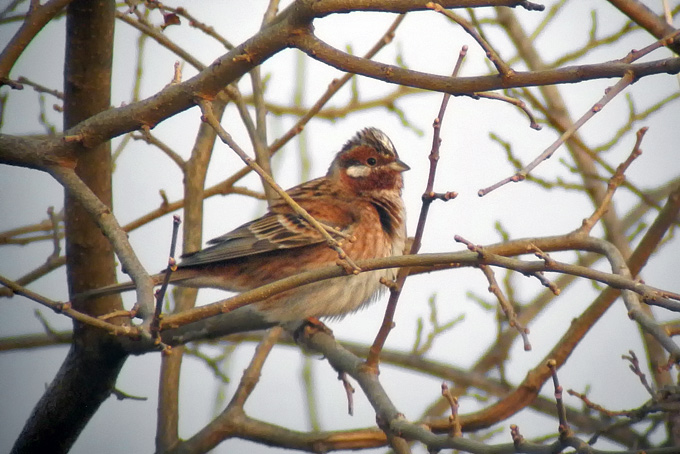
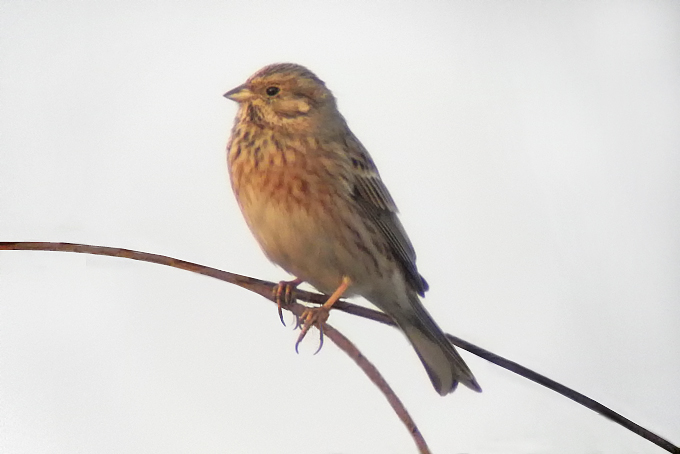
In addition, mammals noted during the week included Korean Water Deer at several sites; Red Squirrel and Siberian Chipmunk at Namhansanseong; Finless Porpoise en route to and Spottted Seal (five) off Baekryeong Island; and single Raccoon Dog and Amur Leopard Cat at Seosan.
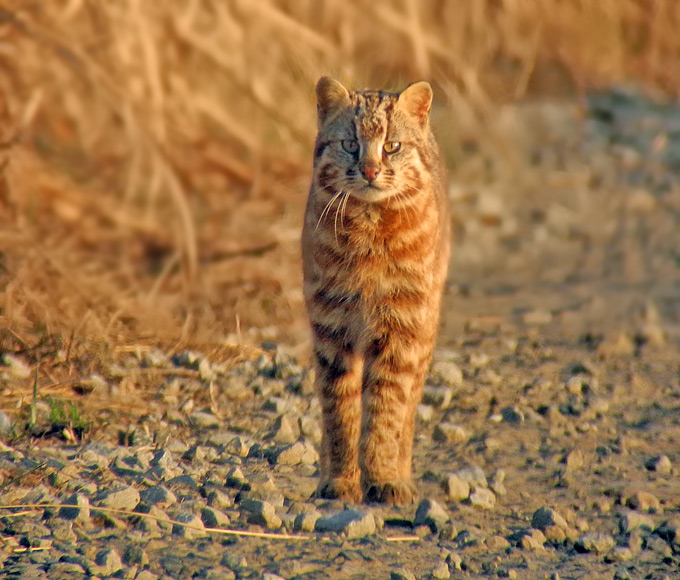
Namhansan, March 21
An afternoon visit to the mountain under mild sunshine: birds included various Varied, Great, Marsh and Long-tailed Tits, some seen and some heard; several Eurasian Nuthatches, a small flock of Yellow-throated Buntings, a distant calling Eurasian Jay, a small flock of Eurasian Siskins eating catkins, several Bramblings, a pair of White-backed Woodpeckers energetically flaying dead tree branches, and a single and vocal Hazel Grouse.



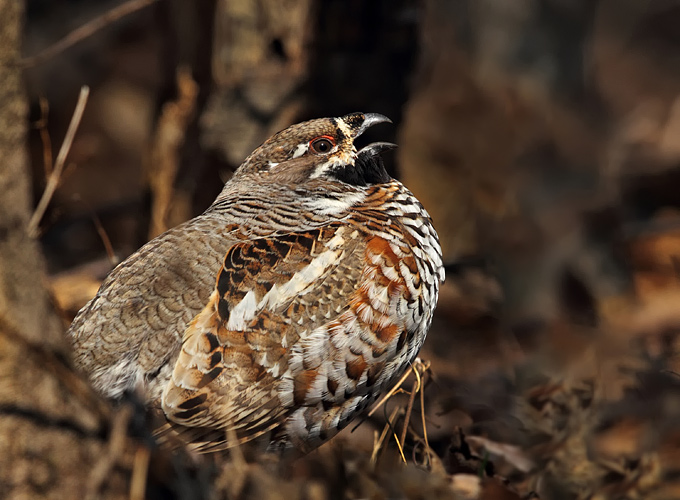
Songdo, March 15 - 16
A flock of Eurasian Curlews and a few Eastern Oystercatchers has been the sum of the shorebird entertainment over the winter at Songdo, so it was great to visit the Gojan mudflats over the weekend and see newly-arrived Dunlins, about 1,000 frantically feeding on the dropping tide, along with 100 Grey Plover and 6 Kentish Plover (these last actually arrived last weekend). Also quite a few Eastern Curlews (I counted 30 but I suspect quite a few more) in among the Eurasian Curlews. And best of all, a single Bar-tailed Godwit on the 15th, starting to get a bit of orange on the undersides. The Dunlin and Grey Plovers were all in winter plumage and I think these came from not too far away. On Sunday, a lone Black-faced Spoonbill was alone in the shallows, maybe wondering why the water was so cold …
The Saunders’s Gulls are nearly all in summer plumage already and feeding on the tidal flats, calling constantly. The Eastern Oystercatchers are also displaying.
In Michuhol Park, only Naumann’s / Dusky Thrushes (60) and Bramblings (50). This winter has been very disappointing for passerines. I have not seen a single Rosefinch all winter and the Varied Tits are absent, and much missed (although a couple of Yellow-bellied Tits have been some compensation). Siberian Accentors have been around and on March 6th, a single Olive-backed Pipit, the first spring arrival.
Mara-do, Jeju, March 15
- Arctic Loon Gavia arctica; 20+ near Sagye harbour
- Streaked Shearwater Calonectris leucomelas; five from the ferry (early?)
- Great Crested Grebe Podiceps cristatus; 90+ near the ferry harbour at Sagye
- Oriental Plover Charadrius veredus; two confiding males in partial breeding plumage
- Black-tailed Gull Larus crassirostris
- Ancient Murrelet Synthliboramphus antiquus; five from the ferry, two in breeding plumage
- Eurasian Magpie Pica pica; three individuals around the village
- Far Eastern Skylark Alauda japonica(*?); 15 or more resting in the short grass, ‘chirruping’ quietly, unlike their counterparts nearby on Jeju proper, that were in full song in the fields
- Barn Swallow Hirundo Rustica; only one seen over the island
- Japanese Bush Warbler Horornis diphone
- Japanese White-eye Zosterops japonicus; 10+ in the small woods at the island’s centre
- Naumann’s Thrush Turdus naumanni
- Dusky Thrush Turdus eunomus
- Daurian Redstart Phoenicurus auroreus
- Blue Rock Thrush Monticola solitarius
- White Wagtail Motacilla alba; two leucopsis
- Richard’s Pipit Anthus richardi
- Grey-capped Greenfinch Chloris sinica; eight in the woods

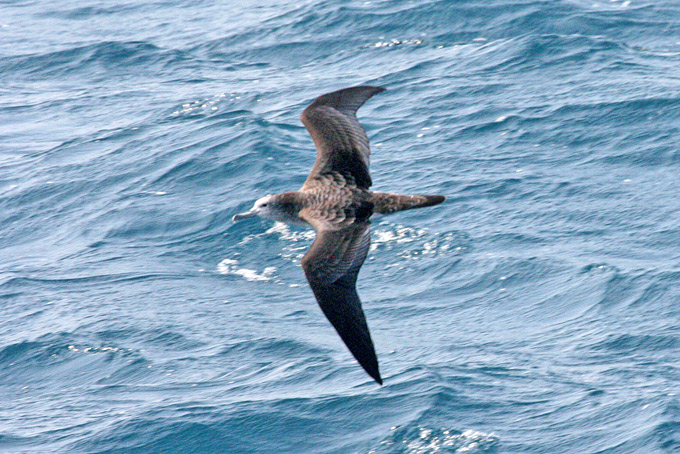
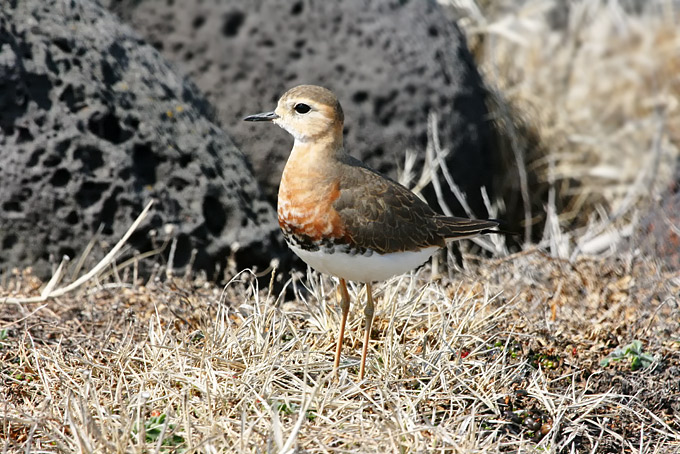
Gangseo, March 15
We visited Gangeso’s River Park to check on the Short-eared Owls. Near dusk, two emerged to course above the fields, sometimes perching in the near distance. Also in the area: 2 Naumann’s Thrushes, scattered Great Cormorants, Great-crested Grebes, Eurasian Teals, Common Pochards, Eastern Spot-billed Ducks, a Little Egret and a Eurasian Kestrel.

Mokpo Namhang Urban Wetland, March 15
A short 45 minutes visit after lunchtime found the site at maximum high tide with sunny and windy conditions. Most birds enjoyed the warming sun in roosting positions. Unfortunately a new construction has started at the corner of the habitat P2 (see more on the Mokpo Namhang Urban Wetland habitat page) just beside the birdwatching hide. A sign tells that the construction is planned to be finished in early 2015 so that it can be assumed that this is the final year for migrant birds at this site in significant numbers. Trucks come very frequently with load to fill in the site. For access they use a road that passes also the habitats P1 and P4 and so the construction is already a huge disturbance for the complete site. This is rather sad, as in the coming days the arrival of shorebirds from New Zealand and Australia is expected.
None the less the place is still very "birdy" with Great Crested Grebe 17, Great Cormorant 43, Grey Heron 19, Little Egret 1, Common Shelduck 97, Eurasian Teal 205, Eastern Spot-billed Duck 162, Mallard 18, Eurasian Wigeon 33, Northern Shoveler 9, Gadwall 54, Eurasian Coot 2, Kentish Plover 6, Common Sandpiper 2, Black-tailed Gull 52, Vega Gull 225, Common Gull 30, Oriental Turtle Dove 9, Brown-eared Bulbul 7, Olive-backed Pipit 11, Black-backed Wagtail 1, Dusky Trush 1, Tree Sparrow 19, Eurasian Magpie 9 counted.
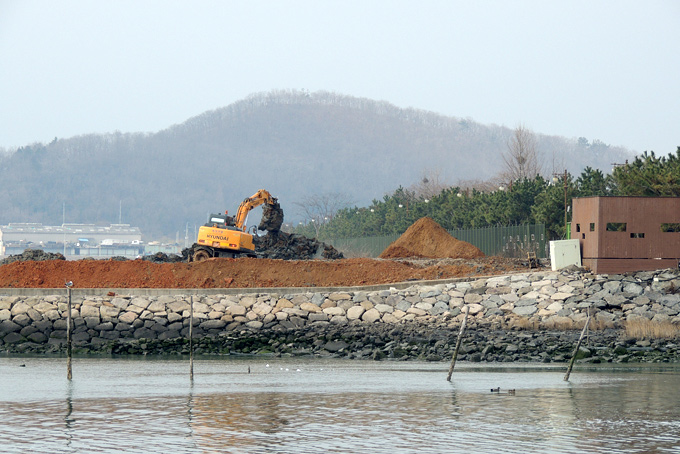


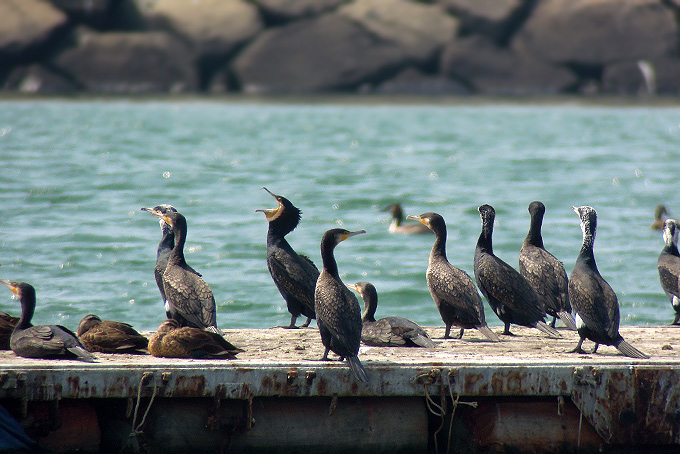
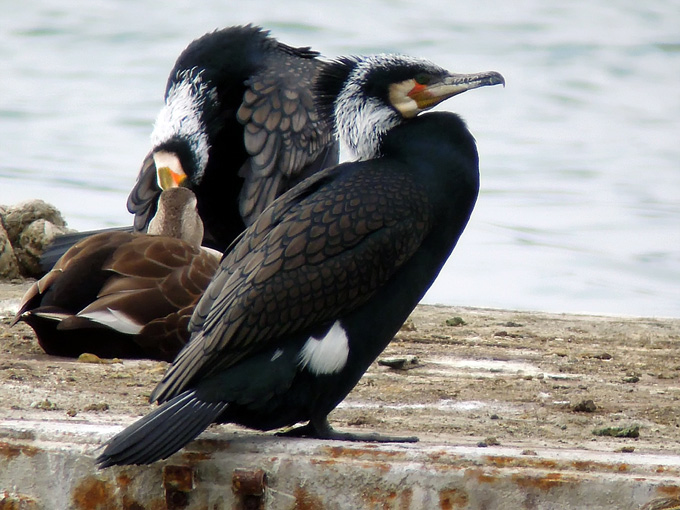
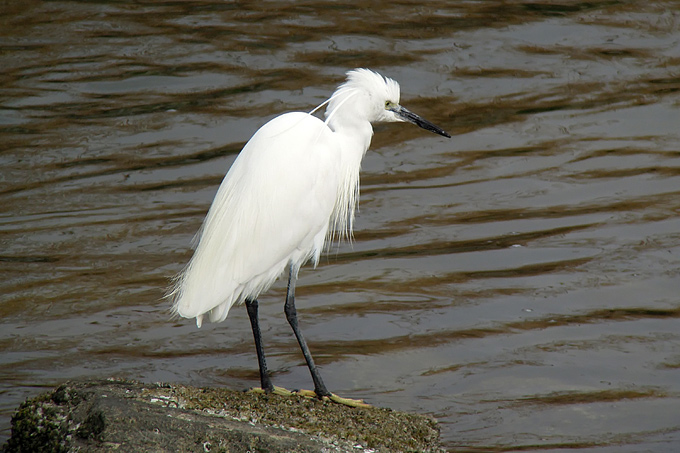
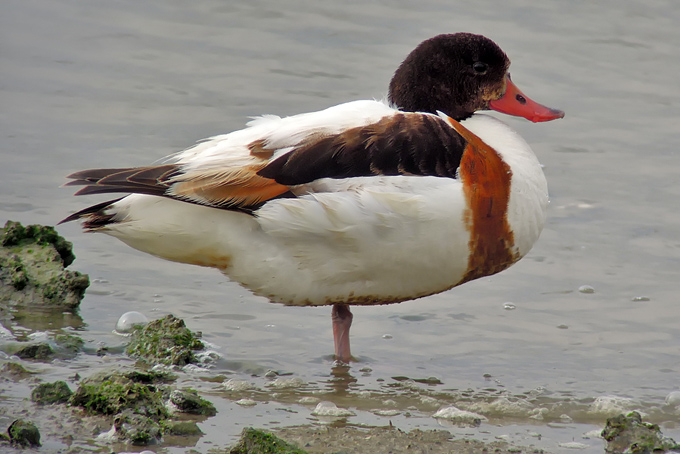

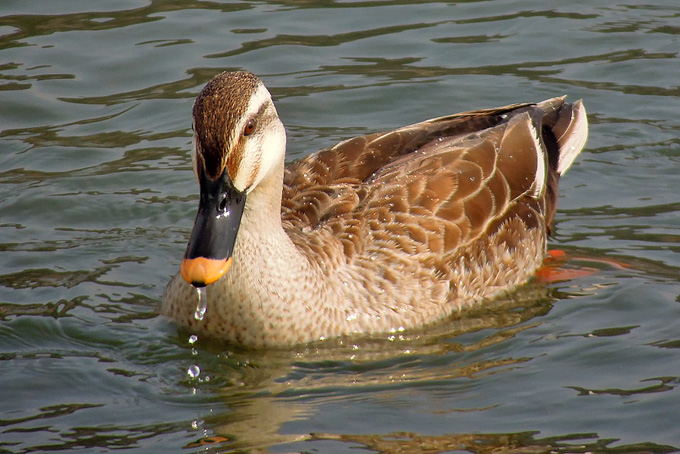
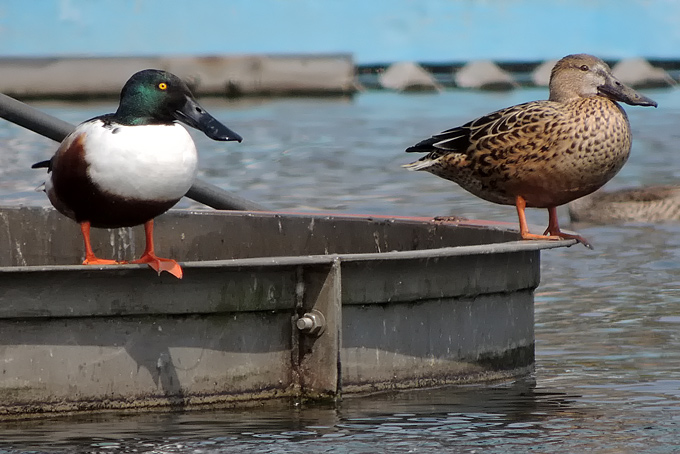
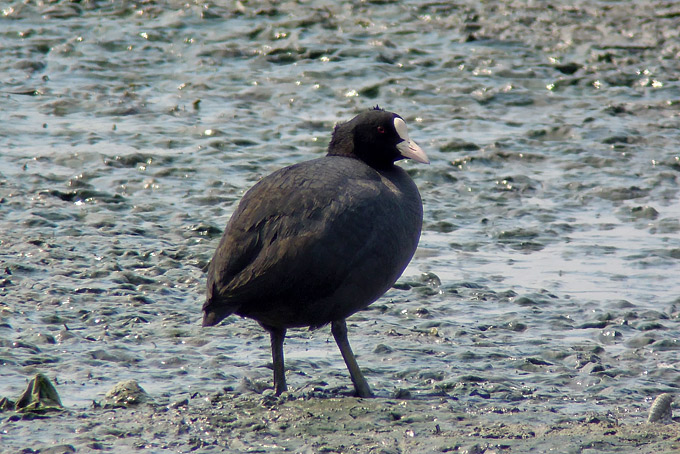
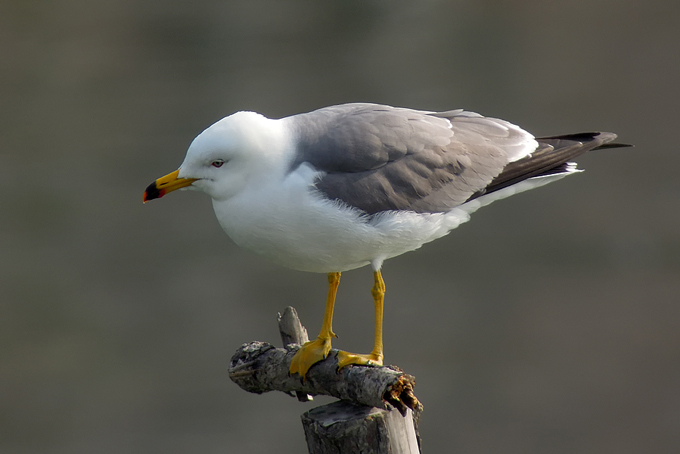
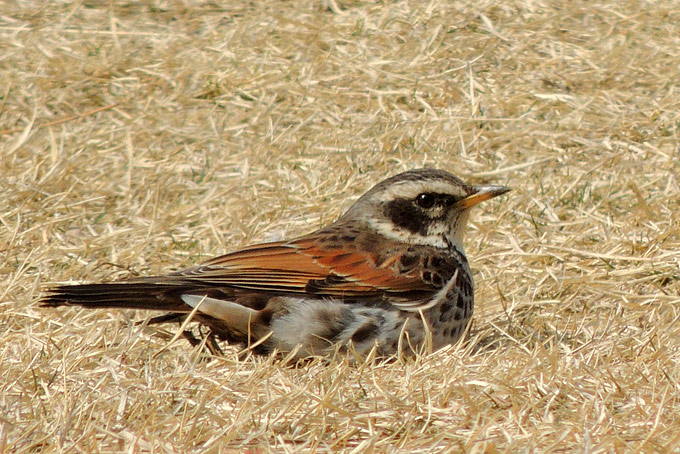
Seogwipo, March 14
At ‘Redpoll Hill’, a brief sighting of a Yellow-browed Warbler on March 4th was followed by a much better listen/look at three individuals on March 13th. On the same day, a single Goldcrest was seen (my first Goldcrest on Jeju in 3+ years), and several Tristram’s Bunting still. Also, a possible Black Wood Pigeon – a large dark pigeon clacked its wings loudly as it took off, then flew strongly through the canopy. On March 14th, I spotted my first Barn Swallows of the year, just east of town. I watched 30+ swooping over an artificial pond for an enjoyable 20 minutes.
Gangneung: National Arboretum, March 14
An afternoon visit to the Sumokwon in cool and partly cloudy weather yielded small flocks of Bramblings, Yellow-throated Buntings and Vinous-throated Parrotbills, single digit counts of Naumann’s Thrush, Eurasian Nuthatch, Hawfinch (1 heard and probably the same later seen), Coal, Marsh, Eastern Great, Long-tailed and Varied Tits, Eurasian Sparrowhawk (1), Far-Eastern Buzzard (2), Japanese Pygmy Woodpecker, Great Spotted Woodpecker, Daurian Redstart, Mandarin Duck and Grey Heron. Highlight was a pair of Black Woodpeckers.
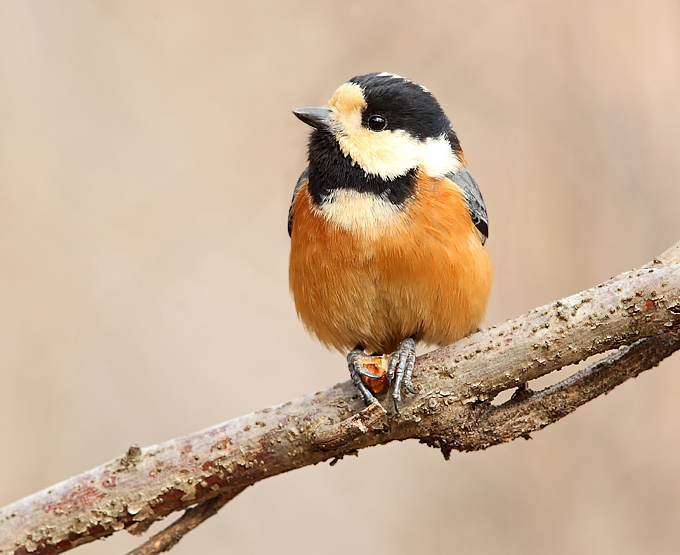
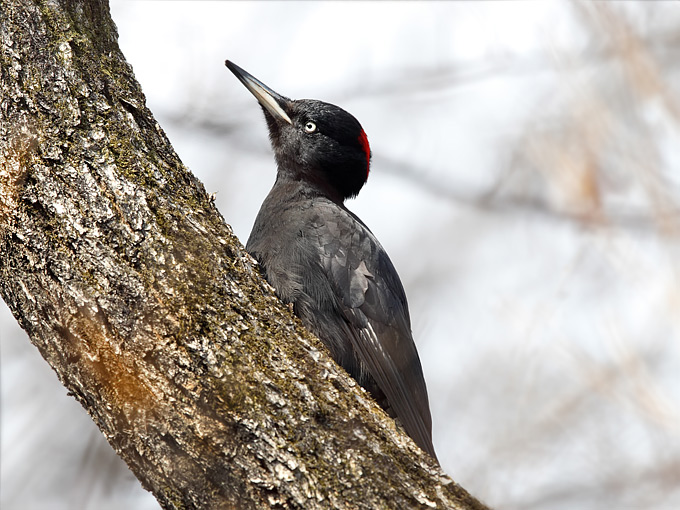
Seoul, March 9
Roofs and sidewalks were dusted with snow this morning, and the day developed crisp and sunny. A call from Mr. Im led to an impromptu and very enjoyable afternoon out to various Seoul hotspots. First call was the Han River near Oksu, where we found the long-staying Baer’s Pochard (only my second sighting in 5 recent visits - the bird can be surprisingly hard to find, bright plumage notwithstanding), 2 “pure-looking” Ferruginous Ducks, one “Ferruginous type,” one possible Common Pochard-(?) hybrid, several Greater Scaup, many but somewhat diminishing numbers of Tufted Ducks and Common Pochards, a scattering of Pintails, Eastern Spot-billed Ducks and Smews, and two Baikal Teal, distant but brilliant in the sunlight.
Word from various birders at Oksu sent us off to Amsa on our way home: there we had brief and occasional views of the famous European Robin. In the periphery, a calling Daurian Redstart.
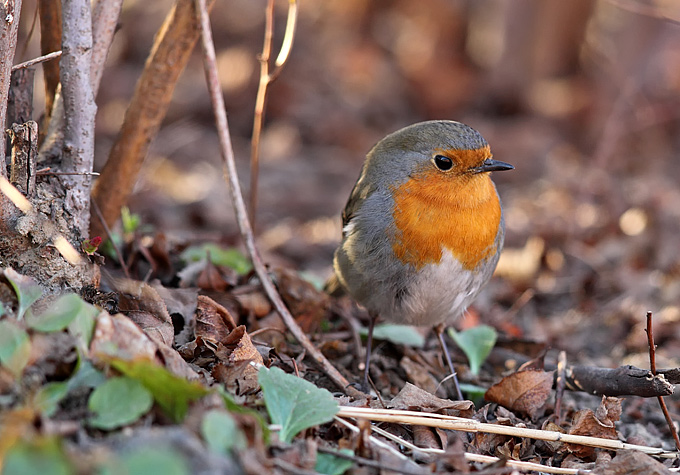
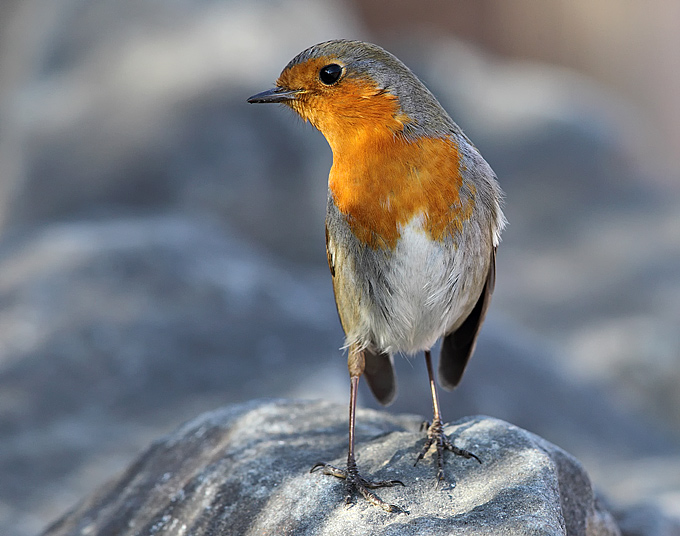
Dobongsan, March 6
Following directions kindly provided by Dr. Shim Kyu Sik, I visited a small tributary to Jungrangcheon in search of two long-staying and highly unusual winter visitors: a Pallas’ Grasshopper Warbler and a Korean Bush Warbler. The former did not show but the Bush Warbler did. Also in the area: a Eurasian Teal, a Brown Dipper, a White Wagtail, a Eurasian Wren, several Great, Varied, and Marsh Tits, a heard Long-tailed Tit, and a Eurasian Kestrel intent upon Vinous-throated Parrotbills.


Gwangju, March 4
A day off from work led to a great morning’s birding at Gwangjuho Lake, outside of East Gwangju. It was cool and mostly overcast, but the birds didn’t seem to notice. Highlights included two singing Japanese Bush Warblers, large flocks of Bramblings, Rustic and Yellow-throated Buntings, most of which were fully molted. The overwintering Long-billed Plover also made an appearance, and a half dozen each of both Naumann’s and Dusky Thrushes topped off the list.
See below for a full list of all the species sighted, 31 in total.
- Common Pheasant Phasianus colchicus; three males, four females
- Mallard Anas platyrhynchos
- Eurasian Teal Anas crecca
- Common Merganser Mergus merganser; a pair of birds
- Grey Heron Ardea cinerea
- Eastern Great Egret Ardea alba modesta
- Long-billed Plover Charadrius placidus; not common at this site, this bird was first observed back in November-December and has been regular ever since
- Oriental Turtle Dove Streptopelia orientalis
- Japanese Pygmy Woodpecker Dendrocopos kizuki
- Great Spotted Woodpecker Dendrocopos major; a pair of birds – the male was drumming
- Grey-headed Woodpecker Picus canus; the resident pair
- Eurasian Jay Garrulus glandarius
- Azure-winged Magpie Cyanopica cyanus
- Eurasian Magpie Pica pica; three separate pairs building nests
- Large-billed Crow Corvus macrorhynchos
- Eastern Great Tit Parus major
- Brown-eared Bulbul Hypsipetes amaurotis
- Japanese Bush Warbler Horornis diphone
- Long-tailed Tit Aegithalos caudacutus
- Vinous-throated Parrotbill Sinosuthora webbiana
- Eurasian Wren Troglodytes troglodytes
- Pale Thrush Turdus pallidus
- Naumann’s Thrush Turdus naumanni
- Dusky Thrush Turdus eunomus
- Daurian Redstart Phoenicurus auroreus
- Eurasian Tree Sparrow Passer montanus
- White Wagtail Motacilla alba lugens
- Brambling Fringilla montifringilla
- Chinese Grosbeak Eophona migratoria; 16 birds – a usual though sporadic winter visitor at the site
- Rustic Bunting Emberiza rustica
- Yellow-throated Bunting Emberiza elegans
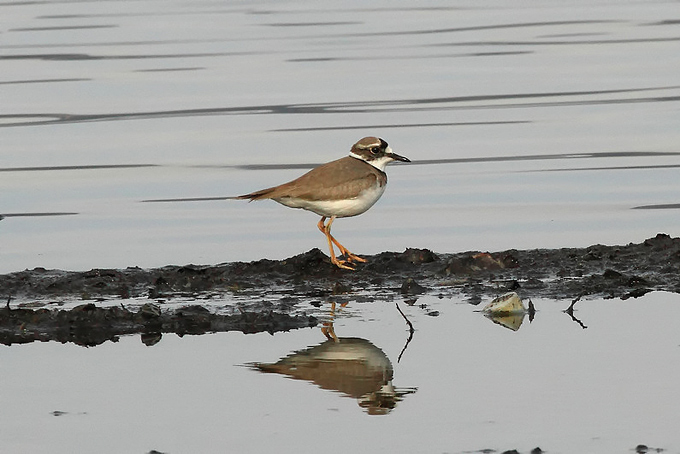
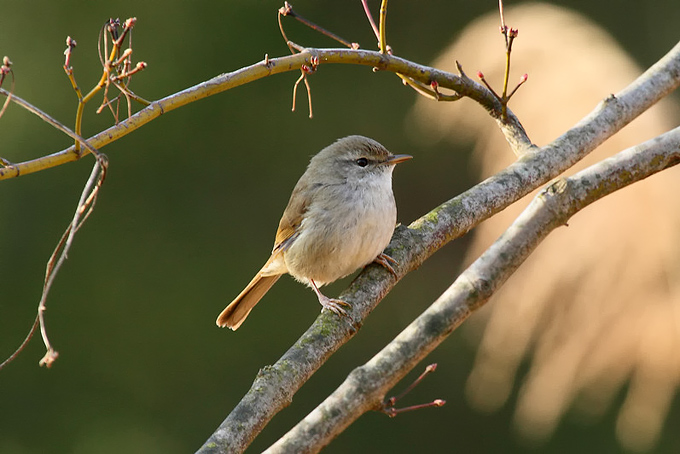
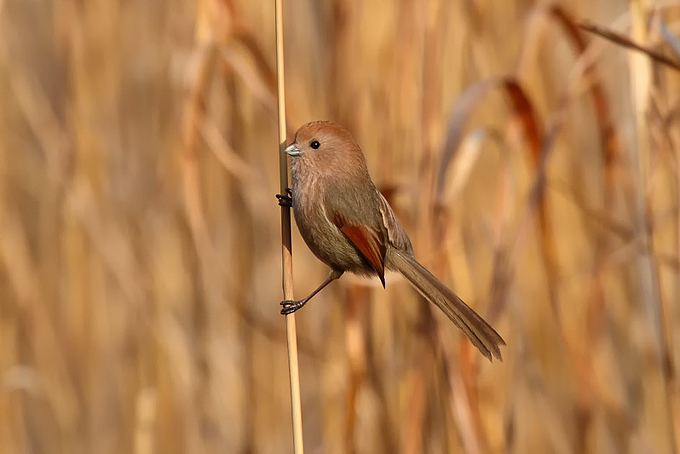
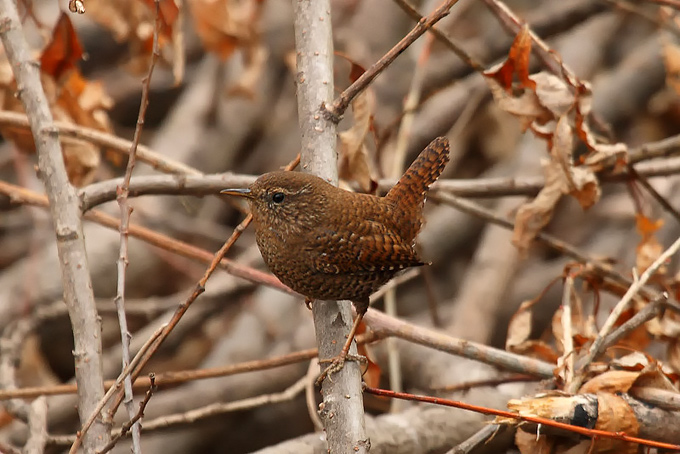
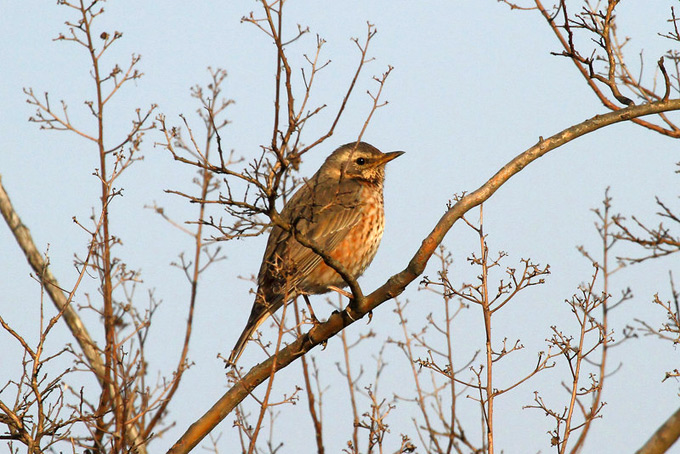
Seogwipo, Jeju, March 1-2
There were some unsolved avian riddles, as well as early signs of spring, on a rainy then sunny weekend. On the same hill where a Common Redpoll was seen two weeks ago, I encountered at least six Tristram’s Buntings skulking in the scrub. I’ve never seen Tristram’s in the winter - could they be early migrants? Also of note were Japanese Bush Warblers in full song, and almost a dozen Long-tailed Tits (I’m still unsure how to separate trivirgatus and magnus Long-tailed Tits) in a nearby gully. Small groups of Olive-backed Pipits and Grey-capped Greenfinch move through the woods and forest edge in several spots.
In the city, I’ve noticed a group of about a dozen White Wagtails noisily moving from the rooftops to one particular large roadside tree, daily just before dusk over the past week. Do White Wagtails communally roost?
In a park in town it seems like Mandarin Duck and Spot-billed Duck (small numbers of Spot-billed do spend the summer on Jeju) numbers have thinned out considerably. Another sign of an early spring? Grey Wagtails and Red-flanked Bluetails can also be found in Seogwipo’s parks.
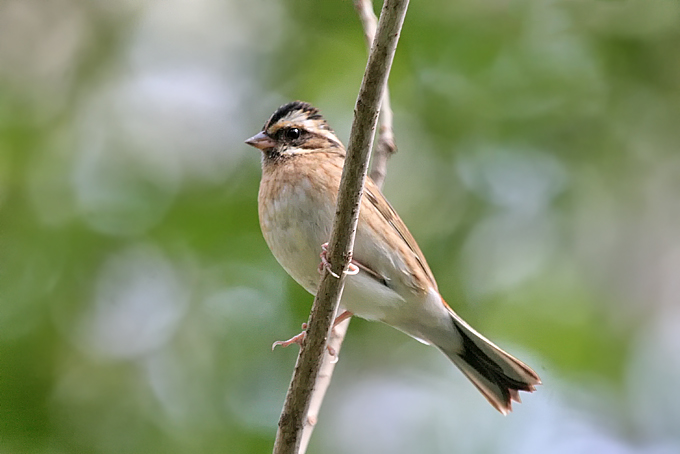
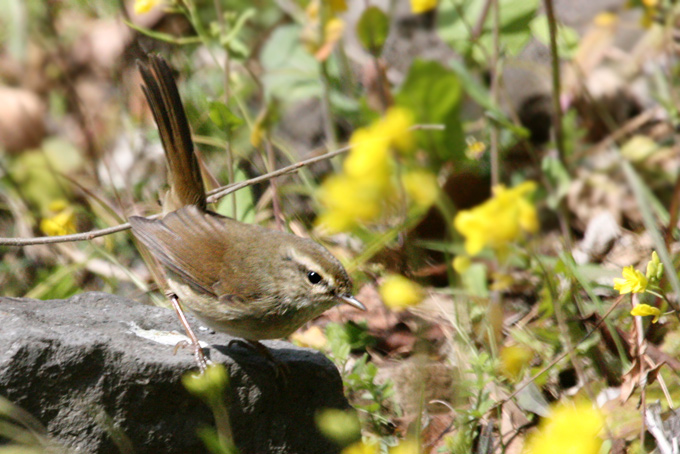
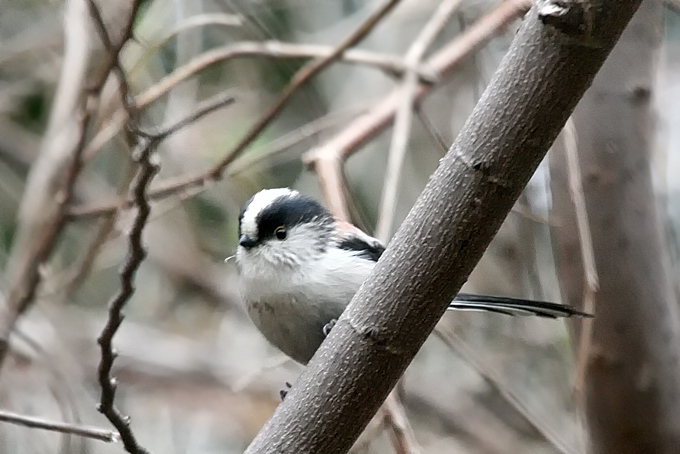
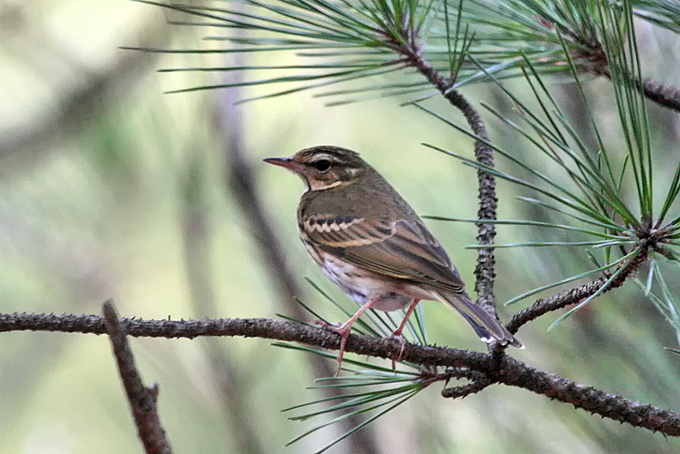
Seoul, March 1
Astonishing news concerns a Pallas’s Grasshopper Warbler found wintering in reeds in a small stream in north-eastern Seoul. First found on December 29th by Ms. Lee Jeong-Suk, the bird was then loosely joined by an overwintering Korean Bush Warbler, first found by the same observer on February 20th. Both were still present on March 1st, when photographed by SKS. Both records are extraordinary. This is the first mid-winter record of Pallas’s Grasshopper Warbler in Korea – a species that should be wintering far to the south. According to Kennerley & Pearson’s book “Reed and Bush Warblers”, this species “occupies an extensive wintering range across much of SE Asia… It winters regularly in Sri Lanka and SC India and from NE India into Burma, Thailand and the Malay Peninsula south to Singapore. There are occasional records of wintering birds from Nepal, SE China, Vietnam, Laos, Sumatra and Java”. Korean Bush Warbler has been recorded in Korea in mid-winter before, but only rarely in the far southwest.


Birds Korea 1108 Ho, 3 Dong, Samick Tower Apt., 148-22, Namcheon-Dong, Su-Young-Gu
Busan, 618-762 Republic of Korea





